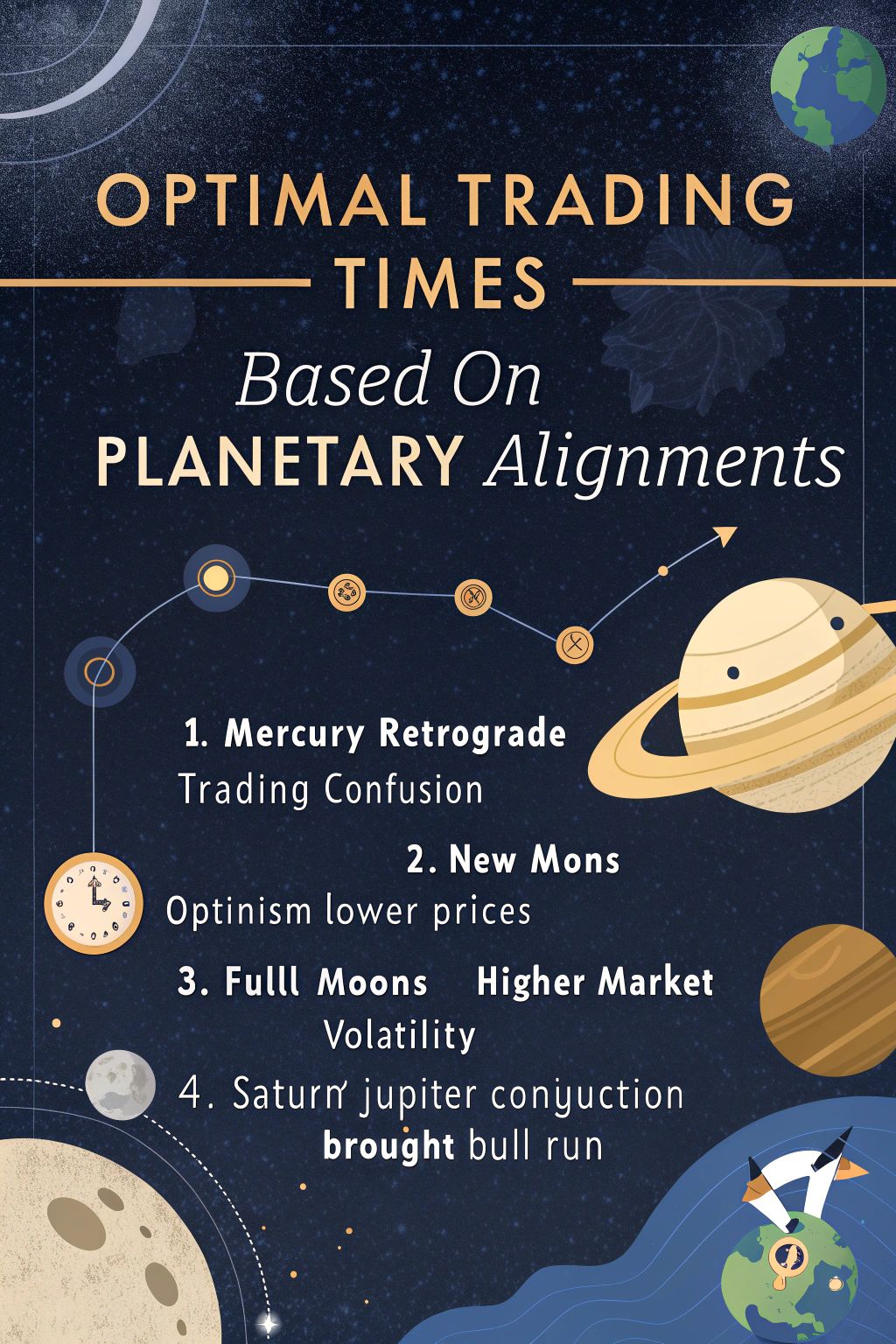Timing the market can feel like chasing shadows. Financial astrology offers a different lens by linking planetary movements to market trends. This post will show how celestial alignments might influence trading strategies.
Keep reading to uncover this cosmic edge!
Principales conclusiones
- Financial astrology links planetary movements to market trends. For example, Mercury retrograde often causes confusion in trading, while full moons increase volatility in assets like Bitcoin.
- Historical examples show correlations. During the December 21, 2020 Saturn-Jupiter conjunction, Bitcoin entered a bullish trend. Gann and other traders used celestial events for predictions.
- Lunar cycles influence markets. New moons tend to bring optimism and lower prices, while full moons create emotional reactions leading to higher volatility.
- Tools like natal charts, solar fire software, and lunar calendars help track planetary alignments. They assist traders in timing entries or exits during events like eclipses or retrogrades.
- Skeptics doubt astrology’s role in trading but case studies prove patterns exist. The June 10, 2021 solar eclipse triggered panic selling behavior across financial markets.

Understanding Financial Astrology
 Financial astrology connects celestial patterns to market trends. Traders use astrological charts and planetary movements to predict shifts in financial markets.
Financial astrology connects celestial patterns to market trends. Traders use astrological charts and planetary movements to predict shifts in financial markets.
Definition and history
Astrology is the study of celestial bodies like planets and their movement. It connects these movements to human events and behaviors. Financial astrology applies this concept to markets, linking planetary positions with market dynamics.
W.D. Gann, a famous trader in the 1900s, used astrological charts for stock predictions. He believed solar flares and sunspots could signal future trends in financial instruments. His techniques still influence how traders use planetary alignments today.
The stars incline us; they do not bind us.
How astrology is used in trading
Traders use astrology to predict market trends by analyzing planetary movements. Mercurio retrógrado often signals market volatility, while Venus and Mars retrogrades can disrupt investor psychology.
Financial astrology also watches lunar cycles like the full moon or new moon to identify shifts in market sentiment. Planetary transits, aspects, and alignments serve as indicators of potential bullish or bearish trends.
Tools like natal charts highlight planetary positions at key events like stock launches or economic changes. Major celestial events such as solar eclipses and lunar eclipses impact stock markets, futures contracts, and commodities trading.
For example, Gann methodologies rely on astrological calculations tied to planetary rulerships for precise timing in investment decisions.
The Impact of Planetary Alignments on Trading
Planets may affect market mood, just like they pull ocean tides. Certain alignments can spark sharp price changes or increase trading activity.
General influence of planets on market behavior
Celestial events often act as triggers for market sentiment. The moon’s phases, like the full moon or new moon, can shift emotions and influence trading decisions. For instance, a new moon may bring cautious optimism, while a full moon might amplify volatility in markets like Bitcoin and commodities.
Retrograde periods, such as Mercury retrograde, are linked to confusion or delays in financial deals. Solar and lunar eclipses sometimes coincide with major turning points in asset prices or stock trends.
These planetary movements impact timing strategies and can affect both short-term trades and long-term investments.
Understanding these patterns helps predict upcoming changes.
Specific impacts on Bitcoin and crypto markets
Planetary alignments can shift market sentiment in Bitcoin and crypto markets. For example, mercury retrogrades often slow decision-making, leading to bearish trends or reduced trading volumes.
Similarly, lunar phases like the new moon may trigger higher price volatility as traders react emotionally.
Outer planets like Saturn and Uranus influence long-term shifts in crypto prices. During Uranus transits, disruptive events such as sudden bullish spikes become common. Astrological indicators during solar eclipses are tied to major turning points in cryptocurrency values, creating opportunities for futures traders looking at short-term gains.
Astrology isn’t just stars—it’s patterns influencing trading psychology.
Historical Data on Planetary Alignments and Market Movements
Some traders study past planetary positions to spot patterns in market moves. For example, they analyze lunar cycles and solar eclipses during major shifts in financial instruments.
Documented correlations between celestial events and market trends
Planetary alignments and lunar phases have shown intriguing links to financial market movements, especially in crypto markets. Below is a summary of documented correlations between celestial events and market trends.
| Celestial Event | Market Trend | Example |
|---|---|---|
| Full Moon | Increased volatility | Bitcoin surges on January 28, 2021 during a full moon |
| New Moon | Temporary market dips | July 10, 2021 saw Bitcoin drop slightly during a new moon |
| Mercury Retrograde | Erratic trading behavior | Stock market turbulence in September 2022 during Mercury retrograde |
| Saturn-Jupiter Conjunction | Shift in long-term market trends | Bitcoin’s bullish trend started after December 21, 2020 conjunction |
| Solar Eclipses | Panic selling behavior | Market correction observed on June 10, 2021 solar eclipse |
| Venus Retrograde | Decline in crypto values | Bitcoin showed bearish patterns during December 2021 retrograde |
| Mars Opposition | Increased market speculation | September 2018 showed speculative Bitcoin trading during opposition |
| Lunar Eclipses | Short-term price spikes | May 26, 2021 lunar eclipse saw Bitcoin recover briefly |
The planets seem to tug at more than just tides. Traders have leveraged these patterns for strategic trading decisions.
Case studies of significant market changes during planetary alignments
NASDAQ once surged during an exact Saturn sextile with the Sun. This aspect connected stability and growth, leading to bullish trends. Traders noticed steady gains during this alignment, proving such aspects influence market behavior.
In another case, “Jnevins” achieved a 117-pip profit using Moon-Sun and Jupiter-Neptune alignments. Jupiter brought expansion, while Neptune introduced idealism. These planetary positions sparked positive shifts in forex markets that day.
Future Projections and Planetary Alignments
Upcoming planetary movements may stir market dynamics in exciting ways. Major celestial events could act as turning points for traders watching the skies and charts closely.
Upcoming significant planetary events
Major planetary alignments can shake market behavior. They may impact crypto, stocks, and other financial instruments.
- Jupiter-Neptune Cycle in Pisces
This 52.69-day cycle impacts trading strategies heavily. The conjunction represents hope amidst uncertainty. It also suggests optimism in bearish trends during challenging market periods.
- 14-Year Synodic Cycle of Jupiter and Neptune
This long cycle highlights themes of growth and imagination in trading environments. Historically, it’s linked with gold price optimism as investors seek stability during times of market doubt.
- Mercury Retrograde Effects
Mercury retrogrades often signal market confusion or reversals. Traders notice increased volatility in assets like Bitcoin or commodity futures around these periods.
- Solar Eclipses and Market Turns
Solar eclipses bring sudden shifts in market sentiment. Past data shows critical price movement days coincide, especially for futures trading.
- Lunar Eclipses’ Influence on Crypto Markets
Lunar eclipses often spark notable action in crypto markets like Bitcoin or Ethereum. These events shift lunar cycles affecting short-term decision-making patterns for traders.
- Mars-Saturn Angles (Trines/Sextiles)
Positive planetary aspects like these inspire stability or slow down drastic fluctuations across sectors such as forex trading or IPO forecasts.
- Planetary Ingress Charts Impacting Market Timing
Major ingress charts mark entry points into new zodiac signs for outer planets tied to ripple effects across commodities and stocks alike.
- Solar Cycles Connecting to Geopolitical Events
A surge in solar activity aligns historically with heightened geopolitical risks influencing oil prices, agricultural commodities, and risk tolerance overall
Predicted impacts on crypto markets
Upcoming planetary alignments could cause market volatility. Mercury retrograde, starting December 13, might shake investor confidence in Bitcoin and altcoins. Historically, such periods increase impulsive trading and exaggerated swings.
The new moon on November 13 signals fresh market cycles. It’s often linked to bullish trends for digital assets like Ethereum. Traders should watch these celestial events closely while balancing risk tolerance with technical analysis tools.
Actionable Trading Tips Based on Planetary Alignments
Timing trades with the moon or planets can offer surprising insights. Learn how to sync your strategy with cosmic patterns for smarter moves.
Best times to buy based on moon phases
The moon affects human behavior and market trends. Its phases can signal key moments for trading.
- New Moon
New Moon often marks a shift in market sentiment. It can trigger trend reversals, which are great for entering markets at lower prices. For example, Bitcoin has shown increased buying opportunities during this phase in past cycles. Traders should monitor the new moon closely using lunar calendars and astrological indicators.
- Waxing Crescent to First Quarter
This period usually reflects growing optimism in markets. Buyers gain confidence as the moon gains light, aligning with a gradual rise in asset prices. This phase supports steady investments or adding to existing positions for long-term gains.
- Full Moon Alignment
A full moon often adds emotional intensity to trading decisions, with high volatility seen in crypto markets like Bitcoin or Ethereum. Buying just before this phase may allow traders to benefit from sentiment-driven rallies sparked by celestial influences.
- Waning Gibbous Phase
As the moon starts fading, some cooling occurs in frantic buying activity but gives way to short-term corrections upward depending on planetary aspects visible within charts tied astrologically back retrogrades major events fostering more price dynamic.sell
Optimal sell points during planetary transitions
Planetary transitions can impact traders’ decisions. These cosmic shifts often align with changes in market sentiment and asset prices. Timing your exit during these periods may lead to better profits.
- Mercury Retrograde
Mercury retrograde brings confusion and market volatility. Stocks and crypto assets often face sharp price dips or unexpected surges. Selling before this phase begins reduces risk of losses from unpredictable swings.
- Full Moon Effects
Full moons create emotional market reactions and higher volatility. Sell positions beforehand to avoid sudden bearish trends or panic-driven drops.
- Solar Eclipses
Markets show instability during solar eclipses due to fear or uncertainty among investors. Exiting trades at least two days before helps lock in gains before moods shift.
- Venus Transitions
Venus governs wealth and financial luck, influencing stock trading trends when it moves across signs or aspects other planets. Selling during certain “unfavorable” zodiac alignments curbs exposure to downturns.
- Saturn Ingress Movements
Saturn ingress charts bring heavy shifts in economic cycles like stricter policies or negative news impacting markets heavily—prompting timely selling opportunities.
- Lunar Cycle Peaks
Peaks near lunar months see momentum slow after a bullish run fueled by earlier optimism tied into new moons; sell-offs usually occur late into waning phases slowing price trajectory ahead clear weaknesses noted tightening strategic profits proactive safely overall
Utilizing planetary hours for short-term trading
Planetary hours can help traders make quick decisions. Each hour is linked to a planet, which influences market behavior.
- Track the planetary ruler of each hour. For example, Mars governs energy and action, which might show in markets during its hour. Use free online tools or apps to check the current planetary ruler.
- Focus on active hours for major decisions. Venus hours may favor harmony and gains in investments such as crypto or NFTs. Mercury’s hours are best for swift trades or contracts due to its connection to communication.
- Avoid risky actions during Saturn’s influence. Its hour may bring delays or losses due to its restrictive nature. Traders with low risk tolerance should stay cautious.
- Trade during Jupiter’s hour for expansion opportunities. It often signals bullish trends and market growth, especially in futures markets.
- Combine lunar cycles with planetary rulers for stronger outcomes. For instance, a full moon in sync with Jupiter boosts optimism in Bitcoin trading patterns.
- Monitor Neptune’s periods for unpredictable trends. Its confusing energy can cloud judgment or cause overfitting when reading market charts.
- Adjust short-term strategies based on sunrise and sunset changes. Planetary transitions shift market sentiment at different times of day, making timing key.
- Align trades with solar eclipses if possible but use proper research first! Historical data shows that celestial influences impact volatile movements during these rare events.
Moon Phases and Bitcoin Trading Patterns
Trading during specific moon phases can reveal patterns in Bitcoin’s behavior. The Waxing Crescent phase often shows bullish trends. During this time, traders might notice increased market optimism and buying activity.
In contrast, the Waning Gibbous phase tends to hint at bearish movements with declining prices and lower confidence.
Lunar cycles also affect short-term trades. Many traders adjust Gann lines to 130 pips for moon settings to refine predictions. For example, a Full Moon may bring higher volatility or sharp price shifts, while New Moons sometimes align with calmer periods.
Tracking these phases helps identify turning points in Bitcoin markets faster than some technical tools alone.
Incorporating Planetary Alignments into Trading Strategy
Blend planetary movements with market patterns to spot turning points and sharpen your trading game.
How to integrate astrology with technical analysis
Combine planetary positions with charting tools like the Gann Box. Identify key support and resistance points based on astro glyphs or planetary movements. Use indicators like lunar cycles and ingress charts to predict possible market turning points.
For instance, full moons often link to shifts in market sentiment.
Overlay astrological indicators with Fibonacci retracements or Bollinger Bands for clearer forecasting methods. Track planetary aspects, such as squares or trines, alongside moving averages for trend confirmation.
A natal chart of major IPO dates can provide insight into long-term price patterns. Keep it simple but precise; align celestial data with technical signals to refine trading strategies efficiently.
Tools and resources for tracking planetary movements
Tracking planetary movements helps traders align with celestial events. Use these tools to stay ahead in financial astrology:
- Square of Nine Chart
This tool highlights price and time targets. It uses planetary positions to predict market turning points. Traders can find key moments for bearish trends or buying opportunities.
- Hexagon Chart
These charts map planetary influences through six circles. They show the effect of transits on crypto markets like Bitcoin. You can use them alongside technical analysis.
- Astrological Calendars
Such calendars list new moons, full moons, eclipses, and other celestial events. They assist in identifying market volatility based on lunar cycles.
- Solar Fire Software
This software creates natal charts and ingress charts. It is widely used for astrological indicators like Mercury retrograde and zodiac aspects.
- Ephemeris Tables
These tables track planetary positions daily. Know when Jupiter or Saturn transit key zones affecting market sentiment.
- Apps Like TimePassages
Easy-to-use apps help monitor planetary hours or solar eclipses on the go.
- Planetary Transits Trackers Online
Websites like Astro.com let users check real-time planetary movements for setting trading strategies.
- Moon Phase Charts
Lunar cycles directly impact Bitcoin patterns as per historical data since 2009.
- Gann Methodologies Tools
Gann astro methodologies blend geometry with astrology for better timing strategies in volatile markets.
- Third-Party Astrology Plugins
Chrome extensions integrate celestial insights into trading platforms, fine-tuning investment decisions fast.
Common Misconceptions and Challenges
Some think astrology in trading is pure guesswork, but patterns often prove otherwise.
Debunking myths around financial astrology
Financial astrology often faces skepticism. Critics argue it’s mere superstition, lacking scientific merit. Yet, history shows correlations between celestial events and market trends.
For instance, traders note increased volatility during mercury retrograde or lunar eclipses.
Subjectivity in interpreting astrological symbols fuels doubt. Errors like those identified by “Mojo1940” in the “RADIX” section emphasize this challenge. Tools like natal charts or ingress charts aim to formalize these predictions but require careful analysis to avoid mistakes.
Dismissing astrology entirely ignores its potential insights into market psychology and timing strategies tied to planetary movements.
Addressing skepticism and enhancing credibility
Skeptics often dismiss financial astrology as guesswork. Yet, history shows patterns between planetary movements and market trends. For instance, Ray Merriam’s 14-year Jupiter-Neptune cycle highlights periods of hope during adversity in economic conditions.
Such correlations reflect how celestial influences might interact with human behavior, shifting market sentiment.
Case studies also support these claims. “Mojo1940” referenced materials like “The Arcana or Stock and Share Key,” which connected solar eclipses to major turning points in markets.
Tools like natal charts and ingress charts further add depth by showing potential triggers for bearish trends or market dynamics. This mix of analysis builds trust while helping traders recognize the value of astrological indicators over time.
Next, let’s explore actionable trading tips based on lunar cycles and planetary transitions!
Conclusión
Astrology offers a fresh lens to trading. Watching planets and their alignments can signal timing shifts in markets. Some traders use this method to spot patterns or turning points, especially with lunar cycles or planetary transits.
While skeptics may shrug, many swear by blending charts with the stars for smarter moves. The key is to stay curious and test strategies that work for you!
For an in-depth analysis of how moon phases correlate with Bitcoin trading patterns, click here.
Preguntas frecuentes
1. What is financial astrology, and how does it relate to trading?
Financial astrology studies planetary movements, lunar cycles, and celestial influences to predict market trends and turning points for investment decisions.
2. Can planetary alignments really affect market timing?
Yes, many traders believe that planetary aspects like full moons, new moons, or mercury retrograde can influence market sentiment and volatility.
3. How do lunar cycles impact trading strategies?
Lunar cycles often mark periods of emotional shifts in markets. For example, some associate bearish trends with certain phases of the moon or eclipses.
4. Are natal charts or ingress charts useful for trading?
Both natal charts and ingress charts are tools in astro methodologies used to analyze planetary transits that may signal important changes in market dynamics.
5. Is technical analysis combined with astrology effective in predicting market moves?
Some traders blend gann methodologies or technical analysis with astrological indicators to refine their strategies around key planetary positions or zodiac signs.
6. Should geopolitical events be considered alongside celestial influences when making trades?
Absolutely! While astrology provides insights into potential timing based on planetary bodies’ movements, external factors like geopolitical events also shape overall market efficiency and dynamics.




